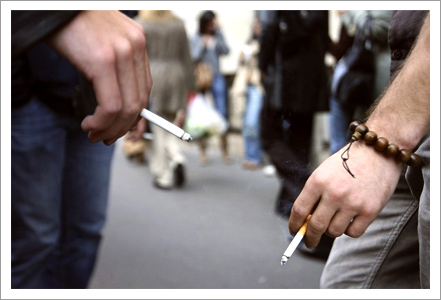Public health authorities hav e concluded that exposure to environmental tobacco smoke (also called second-hand smoke) causes serious diseases in non-smokers, and as a result, governments have prohibited smoking in public places. Regulations that restrict or ban smoking in some or most public places are commonplace in many countries today such as government office buildings, shopping centers, movie theaters, public transportation, the workplace, and, in some countries, the hospitality sector (restaurants, bars and nightclubs).
e concluded that exposure to environmental tobacco smoke (also called second-hand smoke) causes serious diseases in non-smokers, and as a result, governments have prohibited smoking in public places. Regulations that restrict or ban smoking in some or most public places are commonplace in many countries today such as government office buildings, shopping centers, movie theaters, public transportation, the workplace, and, in some countries, the hospitality sector (restaurants, bars and nightclubs).
In the EU, all countries have regulations in place that restrict or ban smoking in public and/or work places, restaurants, bars and nightclubs. Some EU Member States allow narrow exemptions from smoking bans, for instance for separate smoking rooms in the hospitality sector, but others have banned virtually all indoor public smoking. In other regions, many countries have adopted, or are likely to adopt, regulations introducing substantial public smoking restrictions similar to those in the EU. For example, Australia, Canada, Hong Kong, Thailand, Turkey and Ukraine have adopted restrictions similar to those of EU Member States.
Some public health groups have called for, and some municipalities have adopted or proposed, bans on smoking in outdoor places. Some tobacco control groups have advocated banning smoking in cars when minors are present.
Smoke-free & Tobacco-free Places
Scientific evidence on the toxicity of secondhand tobacco smoke is both overwhelming and indisputable. The complex mixture of gases and particles that make up secondhand smoke (also known as environmental tobacco smoke) contains at least 250 chemicals known to be lethal, including more than 50 that can cause cancer. Medical authorities from around the world have concluded that secondhand smoke exposure causes heart disease, stroke, respiratory disease and lung cancer, has immediate adverse effects on the cardiovascular system, and causes sudden infant death syndrome, acute respiratory infections, ear infections, and asthma attacks in children.
In 2006, the U.S. Surgeon General concluded there is no risk-free level of secondhand smoke exposure and that regulating smoking through smoke-free laws and policies is the most effective way to protect individuals from exposure. Not only do the U.S. medical and public health communities vigorously support smoke-free policies, but so do public health communities around the globe.
The first international public health treaty—the World Health Organization's Framework Convention on Tobacco Control—requires participating countries to protect their citizens from secondhand smoke.
Delegates from countries representing 85 percent of the world's population have adopted international guidelines for smoking regulation. These guidelines represent the world's standards for smoking regulations, and include the recommendation that smoke-free laws should completely eliminate smoking in all indoor workplaces and indoor public places.